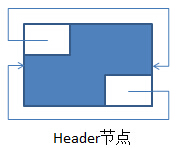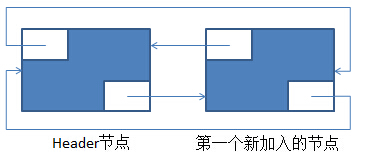第三章 LinkedList源码解析
一、对于LinkedList需要掌握的八点内容
- LinkedList的创建:即构造器
- 往LinkedList中添加对象:即add(E)方法
- 获取LinkedList中的单个对象:即get(int index)方法
- 修改LinkedList中的指定索引的节点的数据set(int index, E element)
- 删除LinkedList中的对象:即remove(E),remove(int index)方法
- 遍历LinkedList中的对象:即iterator,在实际中更常用的是增强型的for循环去做遍历
- 判断对象是否存在于LinkedList中:contain(E)
- LinkedList中对象的排序:主要取决于所采取的排序算法(以后讲)
二、源码分析
2.1、LinkedList的创建
实现方式:
List<String> strList0 = new LinkedList<String>();
源代码:在读源代码之前,首先要知道什么是环形双向链表,参考《算法导论(第二版)》P207
private transient Entry<E> header = new Entry<E>(null, null, null);//底层是双向链表,这时先初始化一个空的header节点
private transient int size = 0;//链表中的所存储的元素个数 /**
* 构造环形双向链表
*/
public LinkedList() {
header.next = header.previous = header;//形成环形双向链表
}
Entry是LinkedList的一个内部类:
/**
* 链表节点
*/
private static class Entry<E> {
E element; //链表节点所存储的数据
Entry<E> next; //当前链表节点的下一节点
Entry<E> previous; //当前链表节点的前一个节点 Entry(E element, Entry<E> next, Entry<E> previous) {
this.element = element;
this.next = next;
this.previous = previous;
}
}
执行完上述的无参构造器后:形成的空环形双向链表如下:

其中,左上角为previous,右下角为next
2.2、往LinkedList中添加对象(add(E e))
实现方式:
strList0.add("hello");
源代码:
/**
* 在链表尾部增加新节点,新节点封装的数据为e
*/
public boolean add(E e) {
addBefore(e, header);//在链表尾部增加新节点,新节点封装的数据为e
return true;
}
/*
* 在链表指定节点entry后增加新节点,新节点封装的数据为e
*/
private Entry<E> addBefore(E e, Entry<E> entry) {
Entry<E> newEntry = new Entry<E>(e, entry, entry.previous);
newEntry.previous.next = newEntry;//新节点的前一个节点的下一节点为该新节点
newEntry.next.previous = newEntry;//新节点的下一个节点的前一节点为该新节点
size++; //链表中元素个数+1
modCount++; //与ArrayList相同,用于在遍历时查看是否发生了add和remove操作
return newEntry;
}
在添加一个元素后的新环形双向链表如下:

在上述的基础上,再调用一次add(E)后,新的环形双向链表如下:

这里,结合着代码注释与图片去看add(E)的源代码就好。
注意:在添加元素方面LinkedList不需要考虑数组扩容和数组复制,只需要新建一个对象,但是需要修改前后两个对象的属性。
2.3、获取LinkedList中的单个对象(get(int index))
实现方式:
strList.get(0);//注意:下标从0开始
源代码:
/**
* 返回索引值为index节点的数据,index从0开始计算
*/
public E get(int index) {
return entry(index).element;
}
/**
* 获取指定index索引位置的节点(需要遍历链表)
*/
private Entry<E> entry(int index) {
//index:0~size-1
if (index < 0 || index >= size)
throw new IndexOutOfBoundsException("Index:"+index+", Size:"+size);
Entry<E> e = header;//头节点:既作为头节点也作为尾节点
if (index < (size >> 1)) {//index<size/2,则说明index在前半个链表中,从前往后找
for (int i = 0; i <= index; i++)
e = e.next;
} else {//index>=size/2,则说明index在后半个链表中,从后往前找
for (int i = size; i > index; i--)
e = e.previous;
}
return e;
}
注意:
- 链表节点的按索引查找,需要遍历链表;而数组不需要。
- header节点既是头节点也是尾节点
- 双向链表的查找,先去判断索引值index是否小于size/2,若小于,从header节点开始,从前往后找;若大于等于,从header节点开始,从后往前找
- size>>1,右移一位等于除以2;左移一位等于乘以2
2.4、修改LinkedList中指定索引的节点的数据:set(int index, E element)
使用方式:
strList.set(0, "world");
源代码:
/**
* 修改指定索引位置index上的节点的数据为element
*/
public E set(int index, E element) {
Entry<E> e = entry(index);//查找index位置的节点
E oldVal = e.element;//获取该节点的旧值
e.element = element;//将新值赋给该节点的element属性
return oldVal;//返回旧值
}
注意:entry(int index)查看上边
2.5、删除LinkedList中的对象
2.5.1、remove(Object o)
使用方式:
strList.remove("world")
源代码:
/**
* 删除第一个出现的指定元数据为o的节点
*/
public boolean remove(Object o) {
if (o == null) {//从前往后删除第一个null
//遍历链表
for (Entry<E> e = header.next; e != header; e = e.next) {
if (e.element == null) {
remove(e);
return true;
}
}
} else {
for (Entry<E> e = header.next; e != header; e = e.next) {
if (o.equals(e.element)) {
remove(e);
return true;
}
}
}
return false;
}
/*
* 删除节点e
*/
private E remove(Entry<E> e) {
//header节点不可删除
if (e == header)
throw new NoSuchElementException(); E result = e.element;
//调整要删除节点的前后节点的指针指向
e.previous.next = e.next;
e.next.previous = e.previous;
//将要删除元素的三个属性置空
e.next = e.previous = null;
e.element = null; size--;//size-1
modCount++;
return result;
}
注意:
- header节点不可删除
2.5.2、remove(int index)
使用方式:
strList.remove(0);
源代码:
/**
* 删除指定索引的节点
*/
public E remove(int index) {
return remove(entry(index));
}
注意:
- remove(entry(index))见上边
- remove(Object o)需要遍历链表,remove(int index)也需要
2.6、判断对象是否存在于LinkedList中(contains(E))
源代码:
/**
* 链表中是否包含指定数据o的节点
*/
public boolean contains(Object o) {
return indexOf(o) != -1;
}
/**
* 从header开始,查找第一个出现o的索引
*/
public int indexOf(Object o) {
int index = 0;
if (o == null) {//从header开始,查找第一个出现null的索引
for (Entry e = header.next; e != header; e = e.next) {
if (e.element == null)
return index;
index++;
}
} else {
for (Entry e = header.next; e != header; e = e.next) {
if (o.equals(e.element))
return index;
index++;
}
}
return -1;
}
注意:
- indexOf(Object o)返回第一个出现的元素o的索引
2.7、遍历LinkedList中的对象(iterator())
使用方式:
List<String> strList = new LinkedList<String>();
strList.add("jigang");
strList.add("nana");
strList.add("nana2"); Iterator<String> it = strList.iterator();
while (it.hasNext()) {
System.out.println(it.next());
}
源代码:iterator()方法是在父类AbstractSequentialList中实现的,
public Iterator<E> iterator() {
return listIterator();
}
listIterator()方法是在父类AbstractList中实现的,
public ListIterator<E> listIterator() {
return listIterator(0);
}
listIterator(int index)方法是在父类AbstractList中实现的,
public ListIterator<E> listIterator(final int index) {
if (index < 0 || index > size())
throw new IndexOutOfBoundsException("Index: " + index);
return new ListItr(index);
}
该方法返回AbstractList的一个内部类ListItr对象
ListItr:
private class ListItr extends Itr implements ListIterator<E> {
ListItr(int index) {
cursor = index;
}
上边这个类并不完整,它继承了内部类Itr,还扩展了一些其他方法(eg.向前查找方法hasPrevious()等),至于hasNext()/next()等方法还是来自于Itr的。
Itr:
private class Itr implements Iterator<E> {
int cursor = 0;//标记位:标记遍历到哪一个元素
int expectedModCount = modCount;//标记位:用于判断是否在遍历的过程中,是否发生了add、remove操作
//检测对象数组是否还有元素
public boolean hasNext() {
return cursor != size();//如果cursor==size,说明已经遍历完了,上一次遍历的是最后一个元素
}
//获取元素
public E next() {
checkForComodification();//检测在遍历的过程中,是否发生了add、remove操作
try {
E next = get(cursor++);
return next;
} catch (IndexOutOfBoundsException e) {//捕获get(cursor++)方法的IndexOutOfBoundsException
checkForComodification();
throw new NoSuchElementException();
}
}
//检测在遍历的过程中,是否发生了add、remove等操作
final void checkForComodification() {
if (modCount != expectedModCount)//发生了add、remove操作,这个我们可以查看add等的源代码,发现会出现modCount++
throw new ConcurrentModificationException();
}
}
注:
- 上述的Itr我去掉了一个此时用不到的方法和属性。
- 这里的get(int index)方法参照2.3所示。
三、总结
- LinkedList基于环形双向链表方式实现,无容量的限制
- 添加元素时不用扩容(直接创建新节点,调整插入节点的前后节点的指针属性的指向即可)
- 线程不安全
- get(int index):需要遍历链表
- remove(Object o)需要遍历链表
- remove(int index)需要遍历链表
- contains(E)需要遍历链表
第三章 LinkedList源码解析的更多相关文章
- 第三章 CopyOnWriteArrayList源码解析
注:在看这篇文章之前,如果对ArrayList底层不清楚的话,建议先去看看ArrayList源码解析. http://www.cnblogs.com/java-zhao/p/5102342.html ...
- LinkedList源码解析
LinkedList是基于链表结构的一种List,在分析LinkedList源码前有必要对链表结构进行说明.1.链表的概念链表是由一系列非连续的节点组成的存储结构,简单分下类的话,链表又分为单向链表和 ...
- Java集合:LinkedList源码解析
Java集合---LinkedList源码解析 一.源码解析1. LinkedList类定义2.LinkedList数据结构原理3.私有属性4.构造方法5.元素添加add()及原理6.删除数据re ...
- 第十四章 Executors源码解析
前边两章介绍了基础线程池ThreadPoolExecutor的使用方式.工作机理.参数详细介绍以及核心源码解析. 具体的介绍请参照: 第十二章 ThreadPoolExecutor使用与工作机理 第十 ...
- 第九章 LinkedBlockingQueue源码解析
1.对于LinkedBlockingQueue需要掌握以下几点 创建 入队(添加元素) 出队(删除元素) 2.创建 Node节点内部类与LinkedBlockingQueue的一些属性 static ...
- 第六章 ReentrantLock源码解析2--释放锁unlock()
最常用的方式: int a = 12; //注意:通常情况下,这个会设置成一个类变量,比如说Segement中的段锁与copyOnWriteArrayList中的全局锁 final Reentrant ...
- Java集合---LinkedList源码解析
一.源码解析1. LinkedList类定义2.LinkedList数据结构原理3.私有属性4.构造方法5.元素添加add()及原理6.删除数据remove()7.数据获取get()8.数据复制clo ...
- ava集合---LinkedList源码解析
一.源码解析 public class LinkedList<E> extends AbstractSequentialList<E> implements List<E ...
- 【vuejs深入三】vue源码解析之二 htmlParse解析器的实现
写在前面 一个好的架构需要经过血与火的历练,一个好的工程师需要经过无数项目的摧残. 昨天博主分析了一下在vue中,最为基础核心的api,parse函数,它的作用是将vue的模板字符串转换成ast,从而 ...
随机推荐
- 《Android源码设计模式》--抽象工厂模式
No1: 4种MediaPlayer Factory分别会生成不同的MediaPlayer基类:StagefrightPlayer.NuPlayerDriver.MidiFile和TestPlayer ...
- <泛> 并查集
最近写这些东西呢,主要是整理一下知识,自己写一遍,看看还是不是我的. 原理与实践相结合,缺一不可 背景 有时候,给你一张很复杂的关系网络图,如果关系具有传递性,那么,我们该如何处理这些关系集合. 一个 ...
- [代码审计]eml企业通讯录管理系统v5.0 存在sql注入
0x00 前言 上周五的时候想练练手,随便找了个系统下载下来看看. 然后发现还有VIP版本,但是VIP要钱,看了一下演示站,貌似也没有什么改变,多了个导入功能?没细看. 搜了一下发现这个系统,压根就没 ...
- Swift2.0语言教程之类的嵌套与可选链接
Swift2.0语言教程之类的嵌套与可选链接 Swift2.0语言类的嵌套 在一个类中可以嵌套一个或者多个类.它们的嵌套形式也是不同的,大致分为了两种:直接嵌套和多次嵌套.下面依次讲解这两种方式. S ...
- quote函数什么意思,怎么用
转自: https://blog.csdn.net/qiqiyingse/article/details/70046543 quote函数 属于urllib库里面的一个函数 屏蔽特殊的字符.比如如果u ...
- Urllib库的基本用法
1.什么是url? 统一资源定位符是对可以从互联网上得到的资源的位置和访问方法的一种简洁的表示,是互联网上标准资源的地址. 基本URL包含模式(或称协议).服务器名称(或IP地址).路径和文件名,如“ ...
- 【10.10校内测试】【线段树维护第k小+删除】【lca+主席树维护前驱后驱】
贪心思想.将a排序后,对于每一个a,找到对应的删除m个后最小的b,每次更新答案即可. 如何删除才是合法并且最优的?首先,对于排了序的a,第$i$个那么之前就应该删除前$i-1$个a对应的b.剩下$m- ...
- [COGS 2066]七十与十七
http://218.28.19.228/cogs/problem/problem.php?pid=2066 [题目描述] 七十君最近爱上了排序算法,于是Ta让十七君给Ta讲冒泡排序. 十七君给七十君 ...
- Codecademy python
#1 print "Welcome to Python!" #2 my_variable = #3 # Set the variables to the values listed ...
- Linux下nmon工具安装及nmon analyser的使用
步骤一:下载nmon及nmon analyser工具 nmon:http://nmon.sourceforge.net/pmwiki.php 根据自己系统的版本下载相应的版本即可 nmon analy ...
